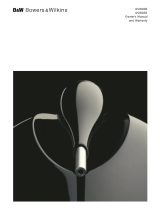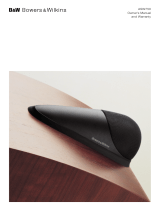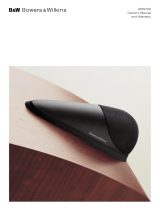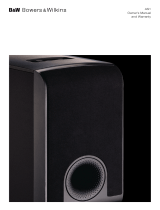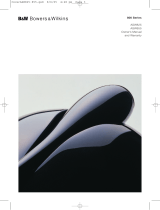13
portrayal, and one more satisfying in the long term, is
to be had by setting the subwoofer level lower than
the standard calibration level.
2-channel Audio
Set the system up in the preferred position and play
some programme with a steady bass content.
The optimum settings of the PHASE switch and the
LOW-PASS FREQ control are inter-related and also
dependent on the low-frequency cut-off characteristic
of the satellite speakers. However, the settings
recommended above for the LOW PASS FREQ control
and PHASE switch have been chosen to integrate well
with most satellite speaker bass alignments.
Using the initial settings, first check the setting of the
PHASE switch. Choose the option that gives the fullest
sound. Normally the recommended option will be
optimum, but may not be in certain circumstances.
These may be that the power amplifiers feeding the
satellite speakers invert the signal or that the
subwoofer is not placed close to the satellite speakers.
Next, adjust the VOLUME (LINE or SPEAKER) of the
subwoofer relative to the satellite systems to your
liking. Use a wide variety of programme material to get
an average setting. A setting that sounds impressive
on one piece may sound overpowering on another.
Listen at a realistic volume level as the perception of
musical balance varies with sound level.
Finally, adjust the LOW-PASS FREQ control to give the
smoothest transition between the subwoofer and
satellite speakers.
All Applications
The BASS EXTENSION switch offers three options of
subwoofer bass extension. Position A gives the
greatest extension and position C gives the least
extension. Position B provides a compromise setting.
If the system is to be used at very high volume levels
or in a large listening room, restricting the bass
extension by selecting either B or C may help ensure
that the subwoofer is not asked to exceed its
performance limits. In most situations the BASS
EXTENSION switch should be left in position A.
The EQ switch alters the subwoofer bass roll-off
alignment. The bass you hear is a combination of the
subwoofer plus the effects of the room and you should
choose the position that best complements your room
and the location of the subwoofer. Position A gives a
“drier” alignment, more suited to placing the
subwoofer in a corner or compensating for a resonant
room. Position B is suited to a less resonant room
acoustic and use away from a corner.
If you get problems with uneven bass – certain bass
notes are exaggerated more than others – then you
probably have a room interface problem and it is worth
experimenting with the location of the subwoofer.
What may seem like small changes in position – 15cm
(6in) or so – can have a profound effect on the sound.
The use of multiple subwoofers can smooth the
effects of room resonances, as each subwoofer will
tend to excite resonances at different frequencies. If
you appreciably alter the relative distances from the
subwoofer(s) and satellite speakers to the listening
position, re-assess the PHASE switch setting. You
should also check the volume of the subwoofer (using
either the processor output levels or the VOLUME
control on the subwoofer amplifier as appropriate), but
only after setting the phase correctly.
Aftercare
The cabinet surfaces usually only require dusting. If
you wish to use an aerosol or other cleaner, remove
the grille first by gently pulling it away from the
cabinet. Spray aerosols onto the cleaning cloth, not
directly onto the product. Test a small area first, as
some cleaning products may damage some of the
surfaces. Avoid products that are abrasive, or contain
acid, alkali or anti-bacterial agents. Do not use
cleaning agents on the drive unit. The grille fabric may
be cleaned with a normal clothes brush whilst the
grille is detached from the cabinet. Avoid touching the
drive unit, as damage may result. Switch off the
subwoofer before cleaning.
Do not use the subwoofer as a table. When in use,
objects left on top of the subwoofer are liable to rattle.
In particular, avoid the risk of liquids being spilled (e.g.
from drinks or vases of flowers).
If the system is taken out of use for a long period,
disconnect the subwoofer from the mains supply.
Limited Warranty
This product has been designed and manufactured to
the highest quality standards. However, if something
does go wrong with this product, B&W Group Ltd. and
its national distributors warrant free of charge labour
(exclusion may apply) and replacement parts in any
country served by an official B&W distributor.
This limited warranty is valid for a period of five years
from the date of purchase or two years for electronics
including amplified loudspeakers.
Terms and Conditions
1 The warranty is limited to the repair of the
equipment. Neither transportation, nor any other
costs, nor any risk for removal, transportation and
installation of products is covered by this warranty.
2 This warranty is only valid for the original owner. It
is not transferable.
3 This warranty will not be applicable in cases other
than defects in materials and/or workmanship at
the time of purchase and will not be applicable:
a. for damages caused by incorrect installation,
connection or packing,
b. for damages caused by any use other than correct
use described in the user manual, negligence,
modifications, or use of parts that are not made or
authorised by B&W,
c. for damages caused by faulty or unsuitable
ancillary equipment,




















